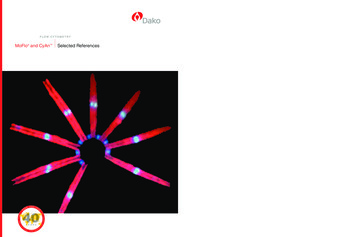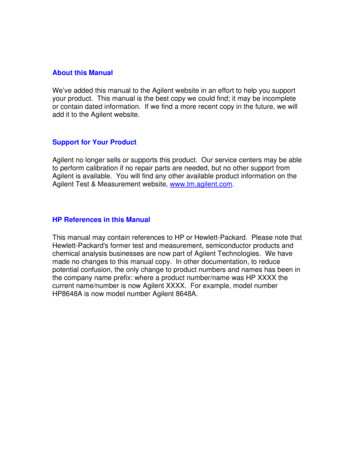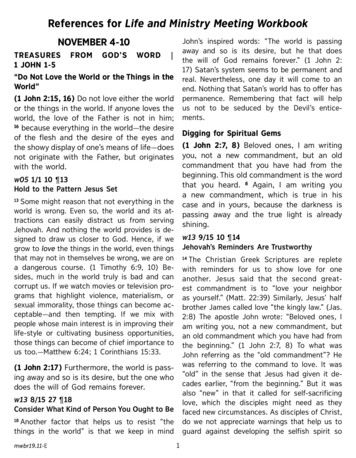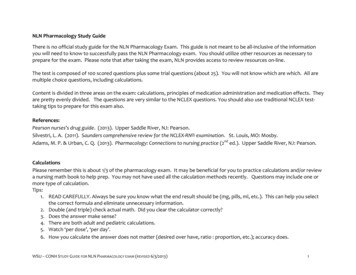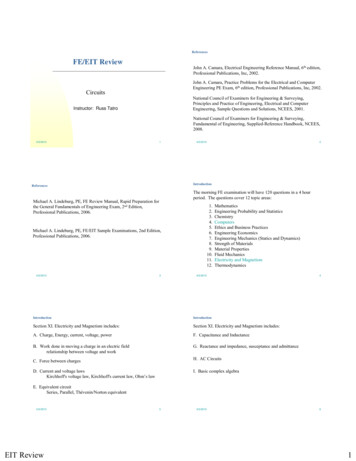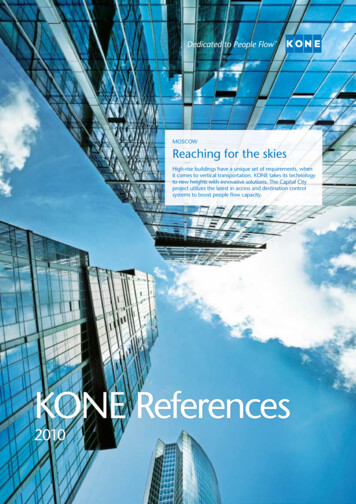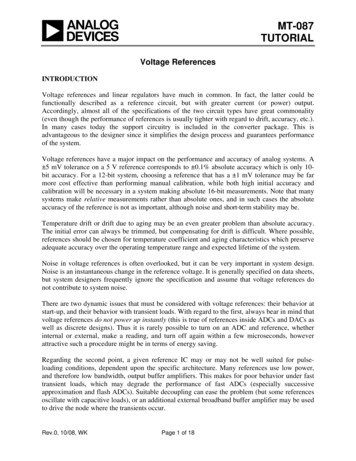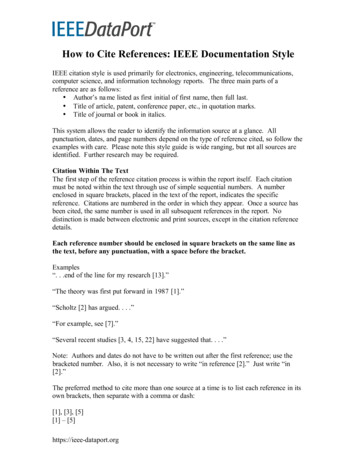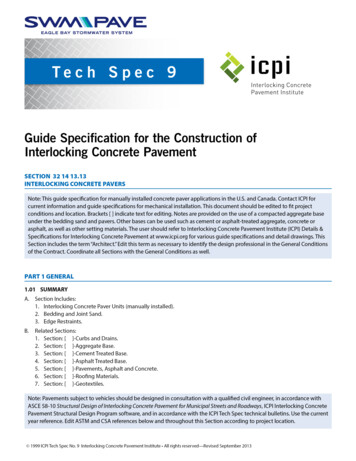
Transcription
1.02 REFERENCESA. American Society for Testing and Materials (ASTM):1. ASTM C 33, Standard Specification for Concrete Aggregates.2. ASTM C 136, Standard Test Method for Sieve Analysis of Fine and Coarse Aggregates.3. ASTM C 140, Standard Test Methods for Sampling and Testing Concrete Masonry Units and Related Units.4. ASTM C 144, Standard Specification for Aggregate for Masonry Mortar.5. ASTM C 936, Standard Specification for Solid Concrete Interlocking Paving Units.6. ASTM C 979, Pigments for Integrally Colored Concrete.7. ASTM D 698, Standard Test Method for Laboratory Compaction Characteristics of Soil Using Standard Effort (12,000 ftlbf/ft3 (600 kN-m/m 3)).8. ASTM D 1557, Test Method for Laboratory Compaction Characteristics of Soil Using Modified Effort (56,000 ft-lbf/ft3(2,700 kN-m/m3)).9. ASTM D 2940, Specification for Graded Aggregate Material for Bases or Subbases for Highways or Airports.B.Canadian Standards Association (CSA):1. A231.2, Precast Concrete Pavers.2. A23.2A, Sieve Analysis of Fine and Coarse Aggregates.3. A23.1-FA1, Concrete Materials and Methods of Concrete Construction.4. A179, Mortar and Grout for Unit Masonry.C.Interlocking Concrete Pavement Institute (ICPI):1. ICPI Tech Spec technical bulletins.D. American Society of Civil Engineers (ASCE)1. 58-10 Structural Design of Interlocking Concrete Pavement for Municipal Streets and Roadways1.03 SUBMITTALSA. In accordance with Conditions of the Contract and Division 1 Submittal Procedures Section.B.Manufacturer’s drawings and details: Indicate perimeter conditions, relationship to adjoining materials and assemblies,[expansion and control joints,] concrete paver [layout,] [patterns,] [color arrangement,] installation [and setting] details.C.Sieve analysis per [ASTM C 136][CSA A23.2A] for grading of bedding and joint sand.D. Concrete pavers:1. [Four] representative full-size samples of each paver type, thickness, color, finish that indicate the range of color variation and texture expected in the finished installation. Color(s) selected by [Architect] [Engineer] [Landscape Architect][Owner] from manufacturer’s available colors.2. Accepted samples become the standard of acceptance for the work.3. Test results from an independent testing laboratory for compliance of paving unit requirements to [ASTM C 936][CSAA231.2].4. Manufacturer’s certification of concrete pavers by ICPI as having met applicable [ASTM][CSA] standards.5. Manufacturer’s catalog product data, installation instructions, and material safety data sheets for the safe handling ofthe specified materials and products.E.Paver Installation Subcontractor:1. A copy of Subcontractor’s current certificate from the Interlocking Concrete Pavement Institute Concrete Paver InstallerCertification program.Note: ICPI certifies that installers have passed an exam on installation knowledge and does not certify or guarantee the qualityof installation. Job references should be carefully reviewed and verified to assist in identifying competent contractors.2. Job references from projects of a similar size and complexity. Provide Owner/Client/General Contractor names andphone numbers.1.04 QUALITY ASSURANCEA. Paving Subcontractor Qualifications:1. Utilize an installer having successfully completed concrete paver installation similar in design, material, and extentindicated on this project.ICPI Tech Spec 9 Page 2
2. Utilize an installer holding a current certificate from the Interlocking Concrete Pavement Institute Concrete Paver Installer Certification program.B.Regulatory Requirements and Approvals: [Specify applicable licensing, bonding or other requirements of regulatory agencies.].C.Mock-Ups:Note: A site visit and approval by the owner’s representative during the first day of paving may substitute for a mock-up.1. Install a 7 ft x 7 ft (2 x 2 m) paver area.2. Use this area to determine surcharge of the bedding sand layer, joint sizes, lines, laying pattern(s), color(s) and texture ofthe job.3. Evaluate the need for protective pads when compacting paving units with architectural finishes.4. This area will be used as the standard by which the work will be judged.5. Subject to acceptance by owner, mock-up may be retained as part of finished work.6. If mock-up is not retained, remove and properly dispose of mock-up.1.05 DELIVERY, STORAGE & HANDLINGA. General: Comply with Division 1 Product Requirement Section.B.Refer to manufacturer’s ordering instructions and lead-time requirements to avoid construction delays.C.Delivery: Deliver materials in manufacturer’s original, unopened, undamaged containers packaging with identificationlabels intact.1. Coordinate delivery and paving schedule to minimize interference with normal use of buildings adjacent to paving.2. Deliver concrete pavers to the site in steel banded, plastic banded or plastic wrapped packaging capable of transfer byfork lift or clamp lift.3. Unload pavers at job site in such a manner that no damage occurs to the product.D. Storage and Protection: Store materials protected such that they are kept free from mud, dirt, and other foreign materials.[Store concrete paver cleaners and sealers per manufacturer’s instructions.]1.06 PROJECT/SITE CONDITIONSA. Environmental Requirements:1. Do not install sand or pavers during heavy rain or snowfall.2. Do not install sand and pavers over frozen base materials.3. Do not install frozen sand or saturated sand.4. Do not install concrete pavers on frozen or saturated sand.1.07 MAINTENANCEA. Extra Materials: Provide [Specify area] [Specify percentage] additional material for use by owner for maintenance and repair.PART 2 PRODUCTS2.01 INTERLOCKING CONCRETE PAVERSNote: In addition to ASTM or CSA conformance, ASCE 58-10 recommends a maximum 3:1 aspect ratio (length thickness) anda minimum 31/8 in. (80 mm) thickness for vehicular applications. Residential driveways should use a minimum 23/8 in. (60 mm)thick units with a maximum 4:1 aspect ratio.A. Manufacturer: [Specify ICPI member manufacturer name.].1. Contact: [Specify ICPI member manufacturer contact information.].B.Interlocking Concrete Paver Units, including the following:1. Paver Type: [Specify name of product group, family, series, etc.].a. Material Standard: Comply with material standards set forth in [ASTM C 936][CSA A231.2].b. Color [and finish]: [Specify color.] [Specify finish].c. Color Pigment Material Standard: Comply with ASTM C 979.ICPI Tech Spec 9 Page 3
Note: Concrete pavers may have spacer bars on each unit. Spacer bars are recommended for mechanically installed paversand for those in heavy vehicular traffic. Manually installed pavers may be installed with or without spacer bars. Verify withmanufacturers that overall dimensions do not include spacer bars.d. Size: [Specify.] inches [({Specify.}mm)] x [Specify.] inches [({Specify}mm)] x [Specify.] inches [({Specify.} mm)] thick.Note: For ASTM C 936 use the following material characteristics:e. Average Compressive Strength: 8,000 psi (55 MPa) with no individual unit under 7,200 psi (50 MPa).f. Average Water Absorption (ASTM C 140): 5% with no unit greater than 7%.g. Freeze/Thaw Resistance (ASTM C 1645): Resistant to 50 freeze-thaw cycles while immersed in water or a 3% salinesolution (depending on conditions during service life) with no greater mass lost than 225 g/m2 of surface areaafter 28 cycles, or 500 g/m2 after 49 cycles. Freeze-thaw testing requirements shall be waived for applications notexposed to freezing conditions.Note: For CSA A231.2 use the following material characteristics:h. Minimum average cube compressive strength of 7,250 psi (50 MPa) for laboratory cured specimens or 5,800 psi (40MPa) for unconditioned field samples.i. Resistance to 28 freeze-thaw cycles while immersed in a 3% saline solution with no greater mass lost than 225 g/m2of surface area after 28 years, or 500 g/m2 after 49 cycles.2.02 PRODUCT SUBSTITUTIONSA. Interlocking concrete pavers: as specified or approved equal.2.03 BEDDING AND JOINT SANDA.Provide bedding and joint sand as follows:1. Clean, non-plastic, free from deleterious or foreign matter, symmetrically shaped, natural or manufactured fromcrushed rock.2. Do not use stone dust.3. Do not use limestone screenings or sand for the bedding that does not conform to the grading requirements of [ASTMC 33][CSA A23.1-FA1].4. Do not use mason sand, or sand conforming to [ASTM C 144][CSA A179] for the bedding sand.Note: If the pavement will be exposed to heavy traffic with trucks, i.e., a major thoroughfare with greater than 1.5 million18-Kip (80 kN) equivalent single axle loads, see ICPI Tech Spec 17–Bedding Sand Selection for Interlocking Concrete Pavements inVehicular Applications for test methods and criteria for assessing bedding sand durability. Limestone screenings will typicallynot meet the durabulity requirements outlined in Tech Spec 17. However, there are some granite materials that can meet theserequirements. Tech Spec 17 recommends using concrete sand as a first preference.4. Where concrete pavers are subject to vehicular traffic, utilize sands that are as hard as practically available.Table 1. Grading Requirements for Bedding SandGradation for Bedding SandASTM C33Sieve Sizein.(9.5 mm)No. 4 (4.75 mm)No. 8 (2.36 mm)No. 16 (1.18 mm)No. 30 (0.6 mm)No. 50 (0.3 mm)No. 100 (0.15 mm)No. 200 (0.075 mm)3/8CSA A23.1 FA1Percent Passing10095 to 10080 to 10050 to 8525 to 605 to 300 to 100 to 1Sieve Size10.0 mm5.0 mm2.5 mm1.25 mm630 µm315 µm160 µm80 µmICPI Tech Spec 9 Page 4Percent Passing10095 to 10080 to 10050 to 9025 to 6510 to 352 to 100 to 1
Note: Bedding sands should conform to ASTM C33 or CSA A23.1 FA1 gradations for concrete sand. For ASTM C33, ICPIrecommends the additional limitations on the No. 200 (0.075 mm) sieve as shown. For CSA A23.1 FA1, ICPI recommendsreducing the maximum passing the 80 μm sieve from 3% to 1%.Table 2. Grading Requirements for Joint SandGradation for Joint SandASTM C144Sieve SizeNo. 4 (4.75 mm)No. 8 (2.36 mm)No. 16 (1.18 mm)No. 30 (0.6 mm)No. 50 (0.3 mm)No. 100 (0.15 mm)No. 200 (0.075 mm)CSA A179Percent Passing10095 to 10070 to 10040 to 7510 to 352 to 150 to 5Sieve Size5.0 mm2.5 mm1.25 mm630 µm315 µm160 µm80 µmPercent Passing10090 to 10085 to 10065 to 9515 to 800 to 350 to 105. Sieve according to [ASTM C 136][CSA A23.2A].6. Bedding Sand Material Requirements: Conform to the grading requirements of [ASTM C 33][CSA A23.1-FA1] with modifications as shown in Table 1.Note: Coarser sand than that specified in Table 2 above may be used for joint sand including C 33 or A23.1 material as shownin Table 1. Use material where the largest sieve size easily enters the smallest joints. For example, if the smallest paver jointsare 2 mm wide, use sand 2 mm and smaller in particle size. If C 33 or A23.1 sand is used for joint sand, extra effort may berequired in sweeping material and compacting the pavers in order to completely fill the joints.7. Joint Sand Material Requirements: Conform to the grading requirements of [ASTM C 144][CSA-A179] as shown withmodifications in Table 2 or meet the requirements for bedding sand in Table 1.Note: Specify specific components of a system, manufactured unit or type of equipment. See ICPI Tech Spec 3–Edge Restraintsfor Interlocking Concrete Pavements for guidance on selection and design of edge restraints.2.04 EDGE RESTRAINTSA. Where not otherwise retained, provide edge restraints installed around the perimeter of all interlocking concrete pavingunit areas as follows:1. Manufacturer: [Specify manufacturer.].2. Material: [Plastic] [Concrete] [Aluminum] [Steel] [Pre-cast concrete] [Cut stone] [Concrete].3. Material Standard: [Specify material standard.].2.05 ACCESSORIESA. Provide accessory materials as follows:Note: Delete article below if geotextile is not used.1. Geotextile:a. Material Type and Description: [Specify material type and description.].b. Material Standard: [Specify material standard.].c. Manufacturer: [Acceptable to interlocking concrete paver manufacturer] [Specify manufacturer.].Note: Delete article below if cleaners, sealers, and/or joint sand stabilizers are not specified.2. [Cleaners] [Sealers] [Joint sand stabilizers]ICPI Tech Spec 9 Page 5
a. Material Type and Description: [Specify material type and description.].b. Material Standard: [Specify material standard.].c. Manufacturer: [Specify manufacturer.].PART 3 EXECUTION3.01 ACCEPTABLE INSTALLERSA. [Specify acceptable paving subcontractors.].3.02 EXAMINATIONA. Acceptance of Site Verification of Conditions:1. General Contractor shall inspect, accept and certify in writing to the paver installation subcontractor that site conditions meet specifications for the following items prior to installation of interlocking concrete pavers.Note: Compaction of the soil subgrade is recommended to at least 98% standard Proctor density per ASTM D 698 forpedestrian areas and residential driveways. Compaction to at least 98% modified Proctor density per ASTM D 1557 isrecommended for areas subject to heavy vehicular traffic. Stabilization of the subgrade and/or base material may benecessary with weak or saturated subgrade soils.a. Verify that subgrade preparation, compacted density and elevations conform to specified requirements.b. Verify that geotextiles, if applicable, have been placed according to drawings and specifications.Note: Local aggregate base materials typical to those used for highway flexible pavements are recommended, or thoseconforming to ASTM D 2940. Compaction of aggregate is recommended to not less than 98% Proctor density in accordancewith ASTM D 698 is recommended for pedestrian areas and residential driveways. Minimum 98% modified Proctor densityaccording to ASTM D 1557 is recommended for vehicular areas. Mechanical tampers are recommended for compaction ofsoil subgrade and aggregate base in areas not accessible to large compaction equipment. Such areas can include that aroundlamp standards, utility structures, building edges, curbs, tree wells a
2. ASTM C 136, Standard Test Method for Sieve Analysis of Fine and Coarse Aggregates. 3. ASTM C 140, Standard Test Methods for Sampling and Testing Concrete Masonry Units and Related Units. 4. ASTM C 144, Standard Speci !cation for Aggregate for Masonry Mortar. 5. ASTM C 936, Standard Speci !cation for Solid Concrete Interlocking Paving Units. 6. ASTM C 979, Pigments for Integrally Colored

